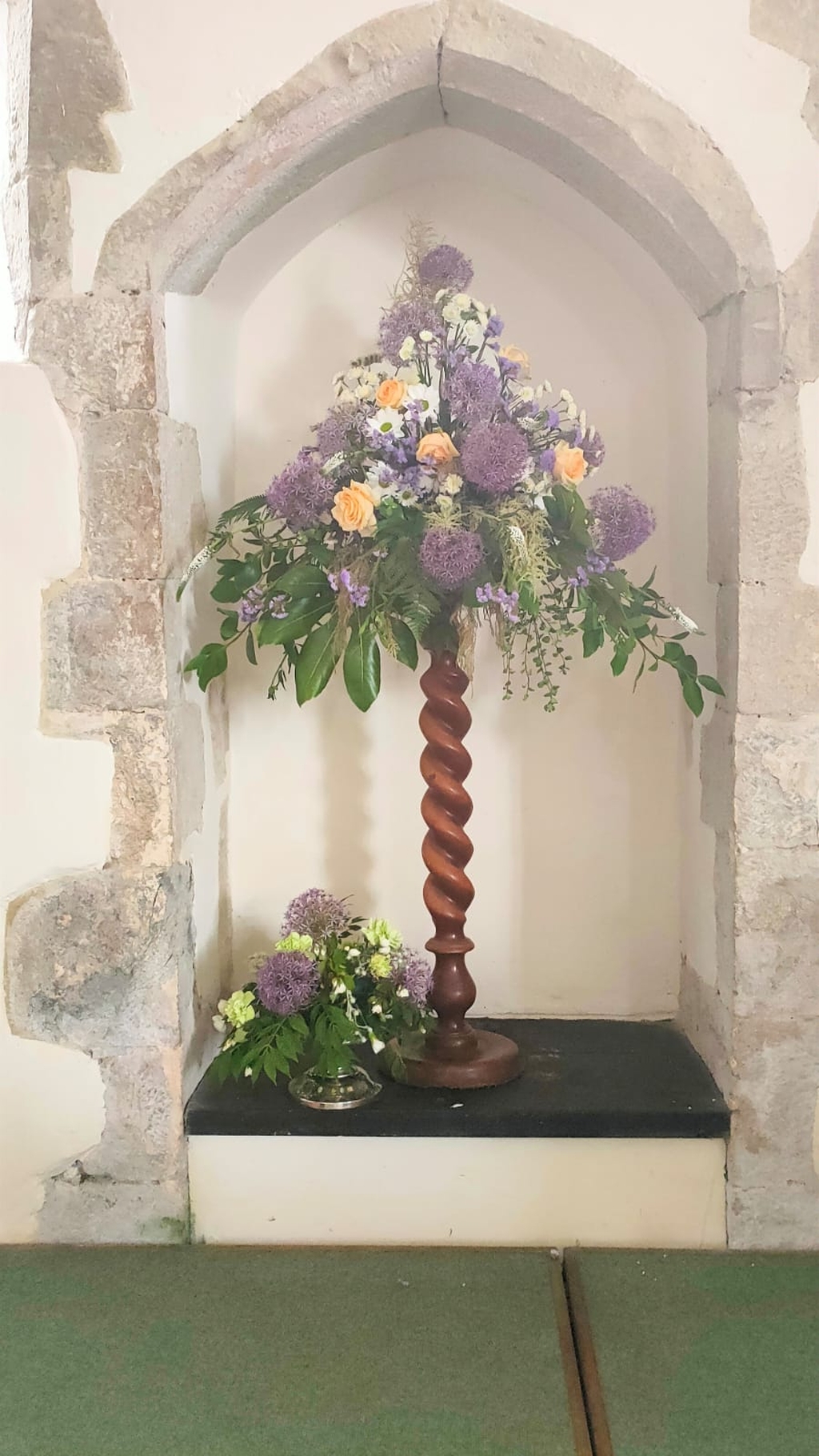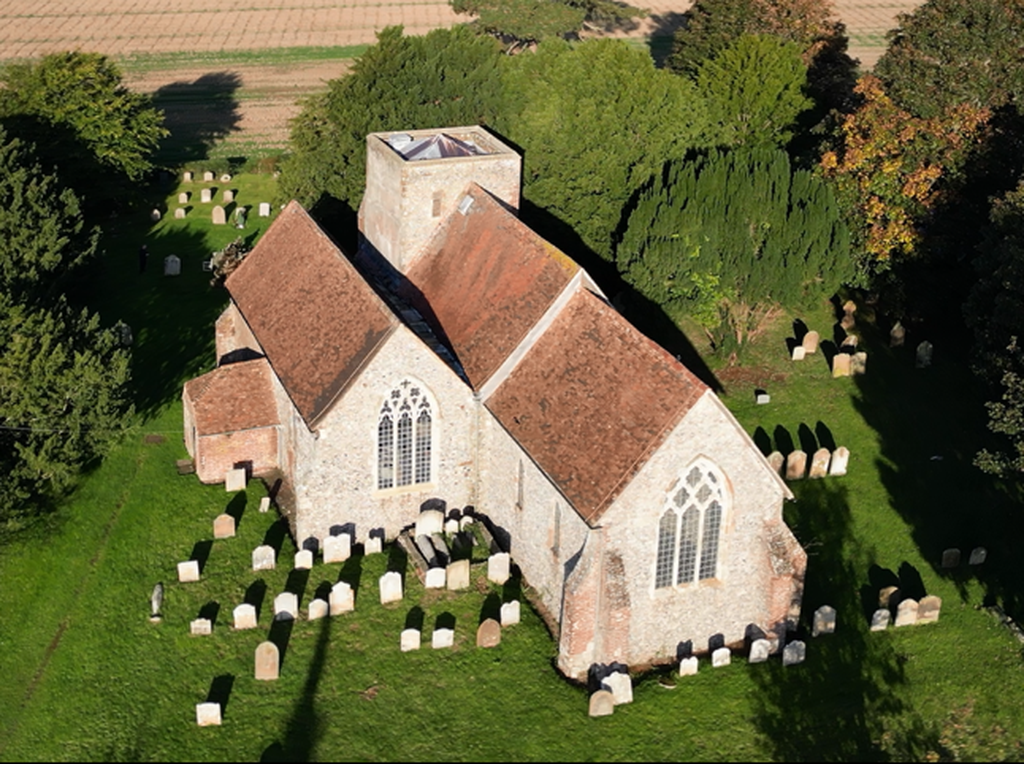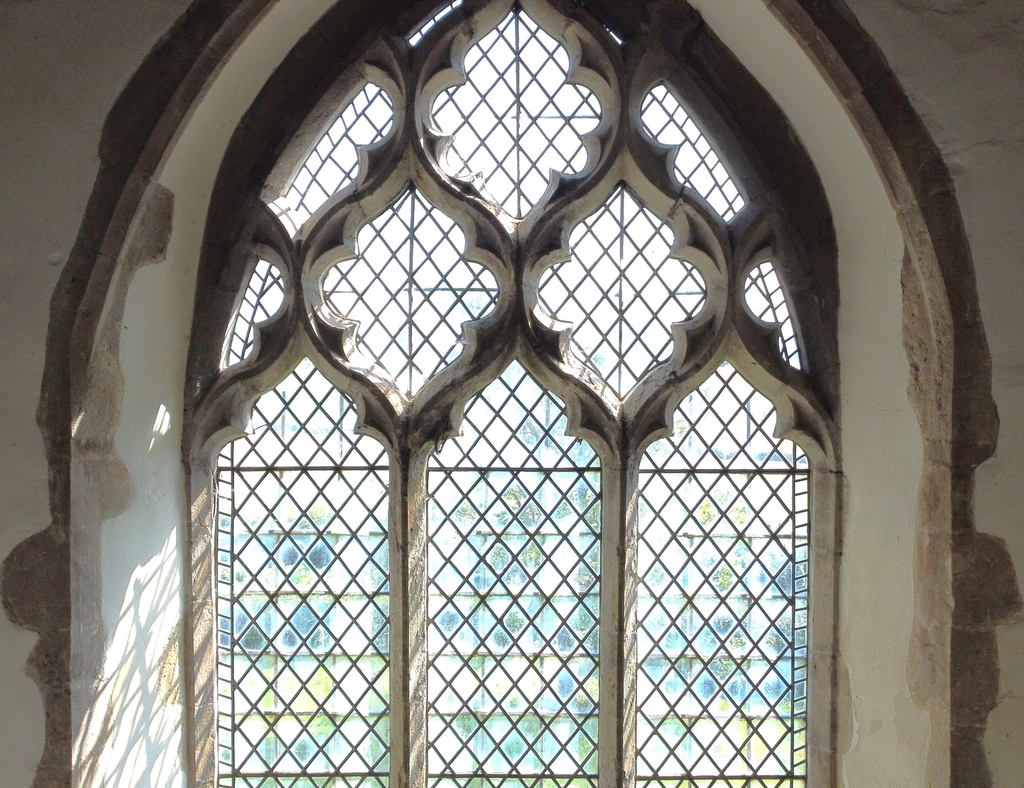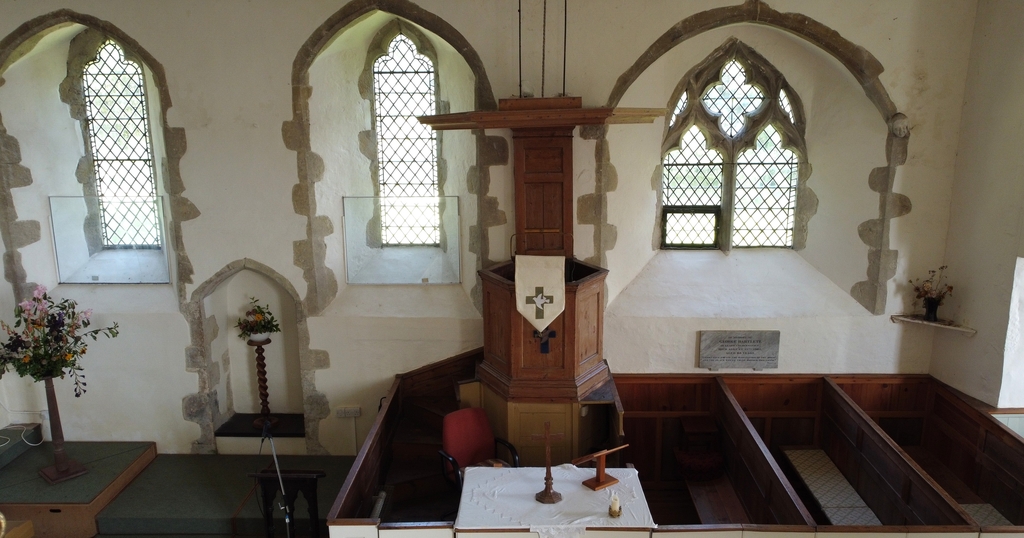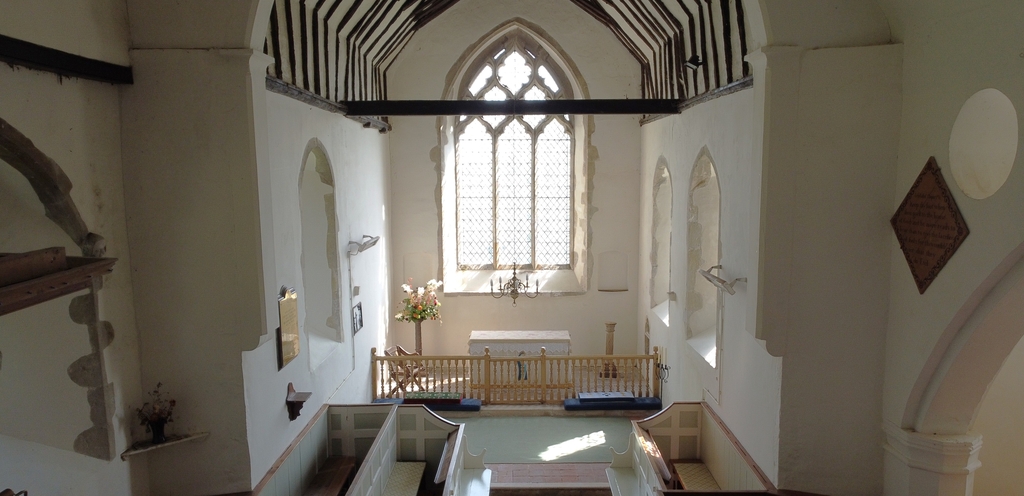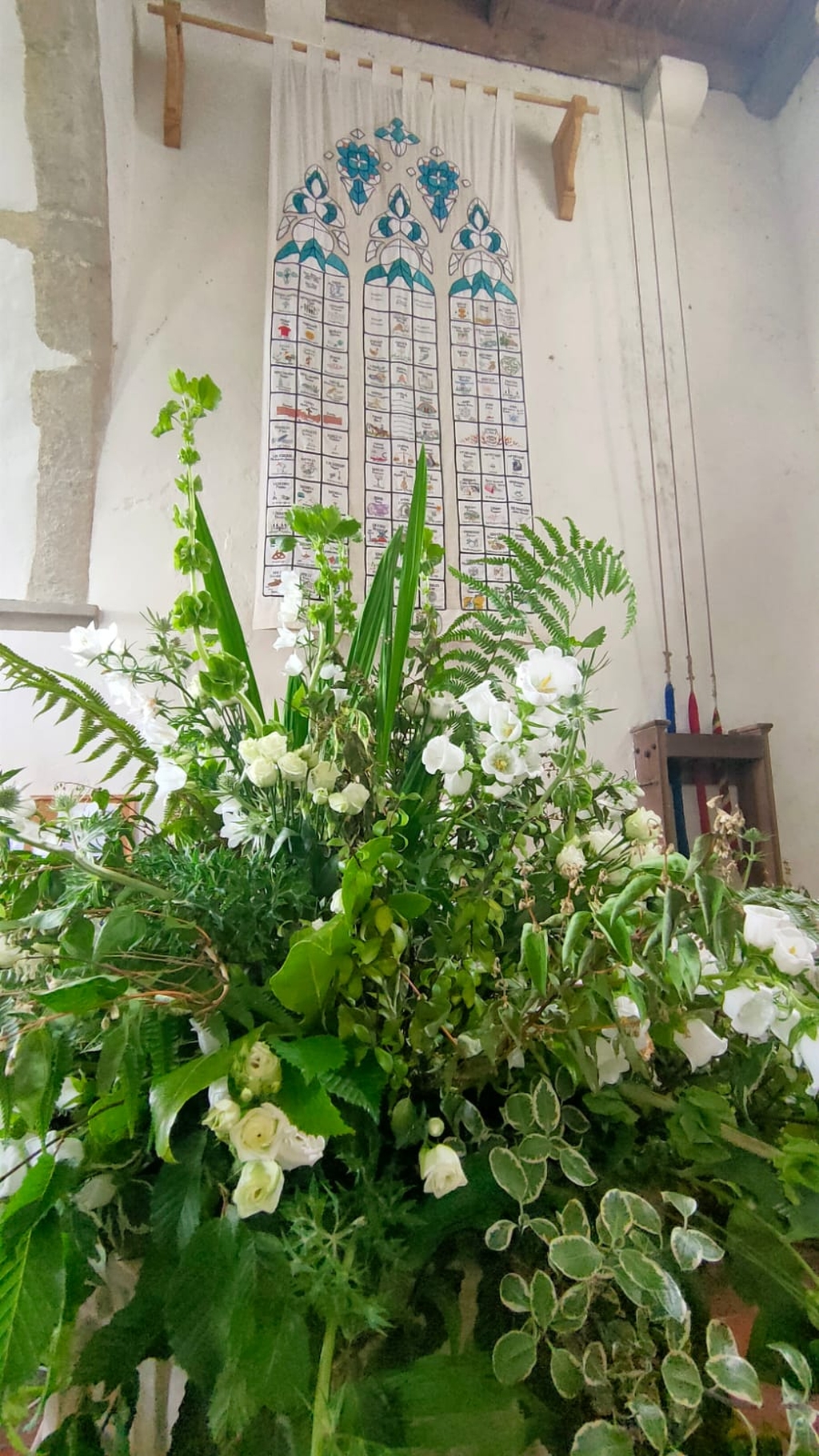About Us
St. Marys Stelling is a welcoming and inclusive church located in Stelling Minnis, Kent, UK. Although an ancient historical building it is a living, working church and all are welcome.
St Marys Stelling dates from the 13th Century, although a church on this site is noted in the Doomsday Book and the date of consecration of Stelling Church is reputed to be 1130. The church started its life as an outlying chapel, first to the basilica at Lyminge, and after the Norman invasion to nearby Hardres. In 1988 the Conservation Foundation, of which Professor David Bellamy was a member, aged one of the Yew Trees (Carbon-Dated) in the churchyard as being 1500 years old. The implication of this, together with the proximity of St Marys to the Roman road linking Canterbury to the Port of Lympne, is that this was an early Christian site dating from the Roman occupation.
St Marys is, on the face of it, a typical east Kent rural church, constructed in flint with stone quoins, and comprising a nave, chancel, south aisle, south porch and tower. It seats approximately 120 people and services are held every other week.
The church, however, is unique and of exceptional importance and is listed in Simon Jenkins’ authoritative book “England’s Thousand Best Churches”. In the 1790s it was re-ordered in a non-conformist style. This involved placing the pulpit midway along the north wall of the nave, (opposite the south aisle), and re-arranging the box pews. Indeed, the Kent Archaeological Society, which is one of the oldest and more respected local historical societies, in referring to the layout of the pews reported that “No-one in the Kent Archaeological Society had seen anything similar in an Anglican church”.
The pulpit itself is a 3-decker pulpit with a sounding board (designed to throw the preacher’s voice back into the congregation), which is understood to be unique in an Anglican church in east Kent. At the same time, a musical gallery was installed above the south aisle facing the pulpit, and to provide a view of the pulpit, the south arcade was removed and replaced by a single large arch. The work included the re-building of the tower (the north wall was totally refaced in brick courses and knapped flint with galletting; the south face was given a tile hanging). A new brick south porch was also constructed. The north doorway was bricked up and a vestry was created at the west end of the south aisle (later to receive a fireplace and flue in its north-east corner). Importantly, this re-ordering was not subsequently altered by 19th century restorers, and we have today a unique non-conformist modification of a medieval church.
After the Civil War, non-conformism in this area became rife. It is quite remarkable that this non-conformism should succeed in invading the established church of St Mary. These changes reflected a strong non-conformist element in the local community, which can also be illustrated by the fact that three Methodist Chapels were built within a mile of the church during the next hundred years. The church is an outstanding historical record for all to see of social and religious development in this corner of Kent.
A further unusual feature of St Marys was revealed in 1999 when the nave ceiling was removed following damage. The roof construction was found to be based on King posts and not Crown posts as is the norm for the churches of this age and style in the area. The Canterbury Archaeological Trust examined and recorded the structure before the ceiling was replaced, and although there is little to be seen to indicate its unusual character, the knowledge of this roof construction adds yet more interest to the building and its history.
The three bells at St Marys are all medieval. The treble bell weighs 3.5 cwt and is probably early 14th century. The second bell weighs 5 cwt and is inscribed with the words “Vox Augustini sonet in aure Dei” – “The voice of Augustine sounds in the ear of God.” The tenor bell weighs 7 cwt and is inscribed with the words “Santa Katerina ora pro robis” – “St Katharine prays for us all.” The last two bells were made by John Walgrave of London in the early part of the 15th century. The bells are still rung today but are unheard by many of the parishioners as the church stands away from most of the population. The reason for this is unclear, although it is thought that much of the village perished during the period of the Black Death, and following this time the settlement moved to the Minnis. The bells were swing chimed until the 1980s when the Ellacombe apparatus was installed.
In 1790, at the time of the re-ordering, the then Vicar of Wye, Reverend Philip Parsons, visited St Marys, and in his book – “The Monuments and Painted Glass of 100 Churches”, tells of the beautiful stained glass in the church. In particular, he describes in the detail the 14th century window in the south aisle. It is not clear where the wealth came to endow the church with such magnificent glass, but within a few years this window was to be removed to St Peters & St Pauls Church at Upper Hardres where it remains to this day, with the exception of the centre light, which is now in Stowting church. The Rev’d Parsons tells us that in other parts of the church there was much painted glass but within a short period of time all this was changed. We do not know what happened to this glass. Could it have found its way to the Cathedral as other glass in the neighbourhood did? This remains part of the history and mystery of this very special church.
St Marys Stelling was closed for repairs from July 1792 to March 1793. The restoration of the church was done at the expense of Mrs Elizabeth Denwood, widow of the Rev’d Thomas Denwood, and one of the heiresses of the Hardres Estate when the last family member died. She had already built the village school in 1784 and now proceeded to restore the church. These events are recorded on a painted board hanging in the church. This board, inscribed by her niece Catharine Chesshyre, include the words “Reader let her deeds speak her praise”.
Although knowledge of the whereabouts of the stained glass is limited, we do have information about the two other treasures – notably the Elizabethan silver chalice dated 1562 and a silver William and Mary flagon dated 1701. These are now on view in the Treasury in Canterbury Cathedral.
The boundary of the churchyard is marked by hedges and flint walls. In 1799 Hasted commented on the “three fine Yew trees of remarkable size”, but unfortunately the one to the south of the tower was blown down in the great storm of 1987. This same storm caused significant damaged to the roof tiles.
The churchyard and its annex contain some fine old tombstones and it is not uncommon to find people from far and wide researching family history visiting for this purpose. A significant amount of research has taken place and it appears that the great, great, great grandfather of Sir Edward Elgar, who was a yeoman farmer and shop-keeper in Stelling Minnis, was buried in the churchyard in 1764.
In 2007 the church launched a major appeal to raise funds for some essential repairs. The latest building inspection had revealed that the wooden joists supporting both the floor and the box pews which were built directly on to the clay beneath, were slowly rotting away. In addition to this, the electrical wiring was in desperate need of updating and significant repairs to the fabric of the building were needed. Following some intense fundraising, the generosity of local residents and grant bodies, sufficient money was available to commence the work in May 2008. The pews were carefully removed, section
by section. A concrete base overlaid with waterproof membranes was placed to support new timber joists, to which a new pine floor was fixed. The box pews were then lovingly replaced.
The extensive work was closely overseen by the Canterbury Archaeological Society. Close examinations of the sub-soil revealed the possible presence of a burial vault beneath the south aisle and evidence of at least four individual graves adjacent to the pulpit was found. Foundations of a former wall in line with the north wall of the chancel and parallel with the existing north wall of the church were also revealed. Accurate records and photographical evidence were collected by the Archaeological Society, but these only pose more questions and add to the mystery which surrounds this unique church.
However, the church is not just a monument to the past. Today St Mary Stelling is a living, active church with an all-age congregation and is the spiritual home to many. Services are held every other week under the leadership of a priest and lay involvement is significant. The church welcomes visitors at any time and an inspection of comments written in the visitors’ book suggests that both local people and travellers from afar recognise the presence of God in this very special place.


